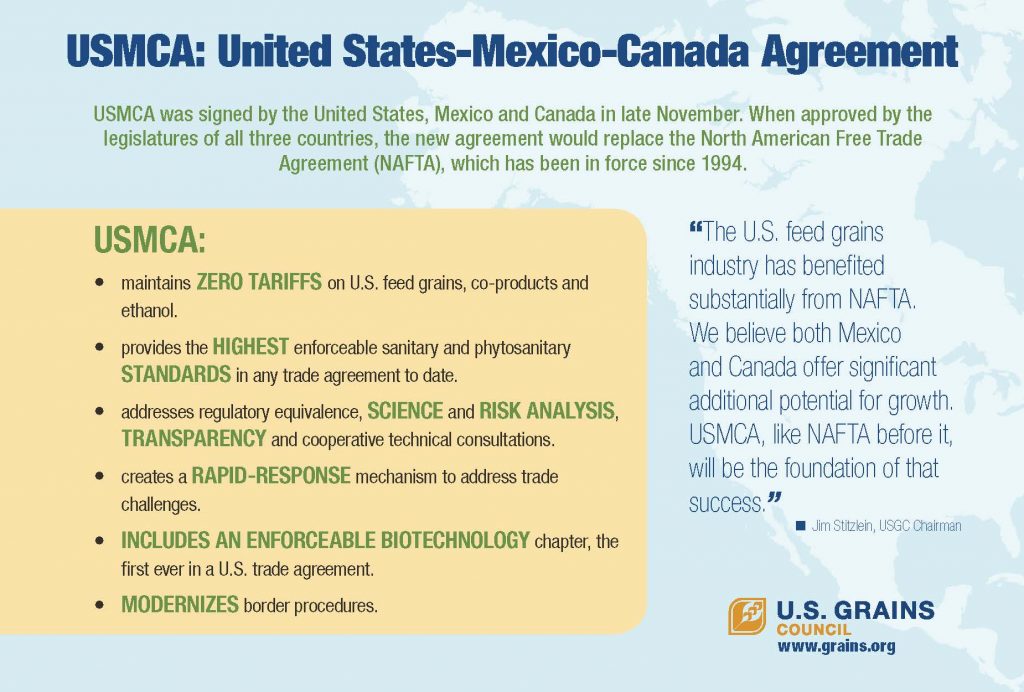The U.S.-Mexico-Canada Agreement (USMCA) officially entered into force on July 1, marking the culmination of efforts to update and improve the North American Free Trade Agreement (NAFTA).
“This agreement solidifies our country’s most important and strategic trade relationships with our best customers and promises further economic growth in tandem with our most-valued partners – Mexico and Canada,” said Darren Armstrong, U.S. Grains Council (USGC) chairman and a farmer in North Carolina.
“We appreciate the administration’s hard-won efforts to deliver and implement an agreement that includes significant improvements and offers more modern approaches to trade, and we thank our partners in both Canada and Mexico whose efforts have been equally appreciated and fruitful.”
From negotiations to ratification, the Council worked and continues to work within the industry and with Canadian and Mexican corn, sorghum, barley, co-products and ethanol customers to ensure the needs of the U.S. grains sector are met and USMCA will build on the success the U.S. experienced under NAFTA.
“We often hosted Mexican buyers to the United States, sent U.S. farmers on missions to Mexico and have continued to market the importance of our trade relationships with our stakeholders in both countries,” Armstrong said. “Both the Council’s leaders and members are very pleased to see USMCA enter into force today and look forward to many prosperous years for our country’s farmers and those in Mexico and Canada.”
USMCA solidifies the trade relationships between U.S. farmers and buyers in two of their most consistent and largest markets. The agreement improves agricultural market access and promotes freer, fairer trade between the three countries. It also provides the framework needed to turn ongoing market development activities into realized sales by:
- maintaining zero tariffs on U.S. coarse grains, co-products and ethanol;
- providing the highest enforceable sanitary and phytosanitary standards in any trade agreement to date;
- addressing regulatory equivalence, science and risk analysis, transparency and cooperative technical consultations;
- creating a rapid-response mechanism to address trade challenges;
- modernizing border procedures; and
- adding an enforceable biotechnology chapter – the first ever in a U.S. trade agreement.
These advantages illustrate the importance of the geographically- and logistically-linked supply chains for U.S. grains in all forms (GIAF) between the United States, Mexico and Canada. The combination of strong policy, robust market development by groups like the Council and its members have created highly successful trade partnerships over the past 25 years. Overall, exports of U.S. GIAF (coarse grains, co-products, ethanol and meat) have increased 309 percent to Mexico and 508 percent to Canada since the start of NAFTA.
Mexico now dominates nearly every category of U.S. grains in all forms – setting a record high in the 2018/2019 marketing year at 25.6 million metric tons, equivalent to one billion bushels. By category, Mexico was the top export buyer of U.S. corn, distiller’s dried grains with solubles (DDGS) and barley/barley products in addition to ranking as the third largest export market for U.S. sorghum and the 10th largest export market for U.S. ethanol.
Canada also set a record for imports of U.S. grain in all forms in 2018/2019, increasing purchases by nearly 10 percent to 8.03 million tons (316 million bushels). Those sales represented the second largest export market for U.S. ethanol and barley/barley products, fifth largest export market for U.S. corn and seventh largest export market for U.S. DDGS.
“No trade agreement has had more impact on the agricultural sector than NAFTA,” Armstrong said. “USMCA, as NAFTA’s successor agreement, is foundational to our global trade policy and critical to the growth of the agricultural sectors in all three countries.”
About The U.S. Grains Council
The U.S. Grains Council develops export markets for U.S. barley, corn, sorghum and related products including distiller’s dried grains with solubles (DDGS) and ethanol. With full-time presence in 28 locations, the Council operates programs in more than 50 countries and the European Union. The Council believes exports are vital to global economic development and to U.S. agriculture’s profitability. Detailed information about the Council and its programs is online at www.grains.org.

